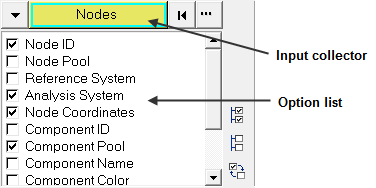Querying Entities
- From the Query panel, click the down arrow next to the input collector to select the entity type.
-
Select the entities to be included in the selection set.
- Click the Nodes, Elements, Components, or Systems input collector and use the extended entity selection menu.
- Pick entities directly from the modeling window using the quick window selection method.
The selected entities are highlighted in the graphics area.Note: Click the reset switch to clear the selection (all options). -
From the Options List, activate the check boxes for the information you would
like displayed in the query table.
The options available in the option list change, depending on the current input collector.

Figure 1.Option Description Model Identifier Displays the source of the data in the table. For instance, p1w1m1 means that the data comes from model 1, which is located on page 1 in window 1. This option is for all entities. Nodes Node ID, Node Pool, Reference System, Analysis System, Node Coordinates, Node Coordinates (Tracked), Component ID, Component Pool, Component Name, Component Color, Part, Original Data, Load Case, and Simulation Step. Note: The Node Coordinates (Tracked) query field will output the node coordinates relative to the tracking system.- The Contour (value) and Contour Resolved-In System options are available if a contour has been applied to nodes or averaged to nodes.
- The Vector (value) and Vector Resolved-In System options are available if a vector plot has been generated at nodes.
- The Tensor (value) and Tensor Resolved-In System options are available if a tensor has been applied to nodes.
Note: For MinLayer/MaxLayer/ExtremeLayer, the query will return the layer name and the value.Elements Element ID, Element Pool, Element Configuration, Element Connectivity, Element Normal, Element Centroid, Component ID, Component Pool, Component Name, Component Color, Part, Load Case, and Simulation Step. The Contour (value) and Contour Resolved-In System options are available if a contour has been applied to elements for centroid or corner results.
The Tensor (value) and Tensor Resolved-In System options are available if a tensor plot has been generated at the element centroid.
Note: For MinLayer/MaxLayer/ExtremeLayer, the query will return the layer name and the value.Components Component ID, Component Pool, Component name, Component Color, Part, Load Case, and Simulation Step. Contour Min/Max, Min/Max ID, Max ID's Pool Name, Min ID's Pool Name, and Contour Resolved-In System options are available if a contour has been applied.
Vector/Tensor Min/Max, Min/Max ID, and Resolved-In System options are available if a vector or tensor plot has been generated.
Note: For MinLayer/MaxLayer/ExtremeLayer, the query will return the layer name and the value.Systems System ID, System Pool, System Type, Origin Coordinates, X axis, Y axis, and Z axis. Note: Click the expansion button, , to bring up the Query Fields dialog. This dialog
lists all the query options currently available (based on the current entity
type that is displayed on the input collector).Tip: Query options can also be selected, or deselected, using the All/None/Reverse buttons:
, to bring up the Query Fields dialog. This dialog
lists all the query options currently available (based on the current entity
type that is displayed on the input collector).Tip: Query options can also be selected, or deselected, using the All/None/Reverse buttons: - All options listed
are selected.
- All options listed
are selected. - No options listed
are selected.
- No options listed
are selected. - Current selection
status is reversed.
- Current selection
status is reversed.
- Optional:
Activate the Remove duplicates check box to remove all
duplicates from the queried nodal data.
This option is enabled when either:
- The native result binding is set to nodal.
OR
- The Average across component boundary option is selected in the Contour or Iso panels.
Note: This option is disabled for all query entity types other than node. -
Click Apply.
The requested information is displayed in the query table.Note: The number and content of the columns in the table depend on the fields selected in the option list on the left side of the panel. For example, if only the ID and Coordinates options are checked, then only those two columns are displayed in the table.Tip: You can sort the data in the table by clicking on one of the selected option headings.Restriction: The cells within the table are disabled and cannot be changed.Note: Highlighted cells can be copied and pasted to other programs.